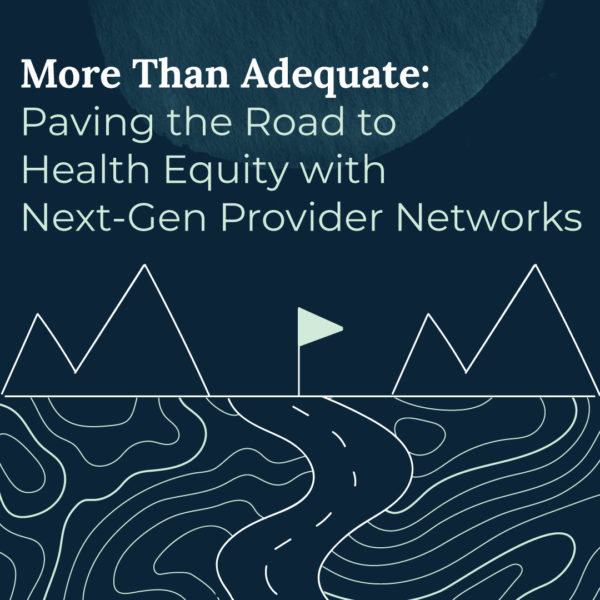
More Than Adequate: Paving the Road to Health Equity with Next-Gen Provider Networks
Download Our Whitepaper “ Of all forms of inequality, inequality in health is the most inhumane ” There are three main contributing factors for health

High-performing provider networks are at the core of a health plan’s success. Embracing digital innovation during the network development process will allow Medicare Advantage plans to secure the best possible partners in an extremely competitive environment.
The Medicare Advantage (MA) marketplace has never been more vibrant. More Americans than ever are opting for the affordable coverage and enhanced benefits that MA plans can offer, with a record 26 million enrollees in 2021.
 Payers are capitalizing on this interest by developing more than 3,500 different MA plans across the nation, giving the average beneficiary over 30 options to choose from.
Payers are capitalizing on this interest by developing more than 3,500 different MA plans across the nation, giving the average beneficiary over 30 options to choose from.
As millions of Americans know, trying to determine the right health plan as a prospective member can be a dizzying task. What fewer know is that it’s also challenging for healthcare providers looking to find the right network to help them grow their practices. In such a competitive marketplace, providers can afford to be just as choosy as members when picking plans to work with.
Providers will be on the lookout for three main criteria: favorable reimbursement rates, large potential patient panels, and seamless administrative processes that keep paperwork to a minimum. Health plan leaders can stay one step ahead of these factors by crafting streamlined, efficient network development operations with the help of innovative tech tools.
Transforming network development into a digital-first process can ensure that MA plans proactively and efficiently manage every step from contracting to credentialing.
What drives network development decision making in the MA environment?
MA plans and providers must consider several different issues when building mutually beneficial relationships.
 Naturally, reimbursement rates are top of mind on both sides of the equation. Providers and health plans will each try to negotiate advantageous payment structures. Their success—or lack thereof—will often be the deciding factor as to whether to move forward.
Naturally, reimbursement rates are top of mind on both sides of the equation. Providers and health plans will each try to negotiate advantageous payment structures. Their success—or lack thereof—will often be the deciding factor as to whether to move forward.
But there’s more to contracting than bargaining over fees for common services. For one thing, providers need to balance a plan’s reimbursement rates with the number of members they have in their service area.
The potential to add a large number of new patients, or even to retain those who have switched to a newly avail- able option in their region, can have a significant impact on a practice’s revenue streams.
Providers may be more willing to accept more modest reimbursements if they can access a larger pool of potential members. Conversely, if the plan does not
have many members that meet the provider’s criteria, they may pass on the opportunity, especially if the payments are not particularly attractive.
Health plans must make some of the same choices when prospecting for new markets and identifying providers to work with.
Are there enough providers with the right mix of specialties to make a new territory viable? Would contracting with these providers potentially add members to the plan? Will the providers generate positive outcomes for members while controlling costs? Are there prominent health systems in the territory that could influence provider decisions about joining a new network?
Even when MA plans and providers can answer these questions to everyone’s satisfaction, there’s more to think about. Both parties need to feel as if they can work well together on a day-to-day basis without miscommunications, delays, or excessive administrative requirements.
That determination often comes down to responsiveness during negotiations, the ease of onboarding, and the ability to work effectively on clinical and financial matters for the duration of the relationship.
All of these pressures combine to make network development a challenging journey that requires coordinated, data-driven effort on the part of MA plans aiming to maximize their opportunities in new and existing markets.
 Identifying opportunities to improve experiences from recruiting to reporting.
Identifying opportunities to improve experiences from recruiting to reporting.
As the Medicare Advantage environment gets more crowded, MA plans can’t afford to rely on antiquated strategies and largely manual approaches to build their networks.
To attract first-choice providers and create desirable options for prospective members, health plans need to identify and eliminate pain points throughout the network development process.
Leveraging emerging technologies in the following high priority areas can help health plans offer industry leading experiences while amping up their efficiency and effectiveness.
 1. Fine-tuning provider outreach and recruiting
1. Fine-tuning provider outreach and recruiting
With dozens of health plans vying for the limited attention of practice staff, MA plans have to make sure they prioritize providers’ time. Frequent unwanted calls or misdirect- ed emails can leave providers feeling irritated and less likely to engage.
One simple way to leave a good impression is to carefully track outreach activities with a unified recruiting platform. This allows team members to coordinate their outreach activities and avoid leaving duplicate messages for a provider who is in the middle of a process or has already been ruled out for the current cycle.
Outreach activity tracking tools enable staff members to focus their efforts on the best possible recruits and follow up quickly when a provider signals their intention to begin contracting. MA plans can also use outreach tracking tools to get a head start on forecasting network progress in real-time, monitoring team efficiency, and preparing for internal audits.
![]() 2. Reducing administrative burdens during contracting
2. Reducing administrative burdens during contracting
Contracting is one of the most error-prone parts of the network development process. From miscommunications over reimbursement details to unreadable faxes or missing signatures on documents, shepherding a contract through to completion takes a huge amount of time and manual effort.
Relatively simple technology fixes, such as encouraging practices to use trusted electronic signature tools, can produce major gains in efficiency. Though many providers still prefer to print out contracts and sign them the traditional way, more and more practices are beginning to see the benefits of keep- ing their documents digital.
Offering a provider portal to complement these efforts can be game changing for health plan staff and practice administrators. With the right provider portal, office staff can view their contracts, address any pending tasks, and review their demographic and facility information without having to enter the same data again and again.
Health plan leaders can also smooth out the steps of contracting for their own staff with real-time re- sponse management tools and provider status dashboards. With these capabilities, MA plans always know exactly what each practice still needs to deliver so that nothing falls through the cracks.
Completing the contracting phase quickly and efficiently allows plans to launch in new markets sooner so providers can start delivering crucial care to their patients.
 3. Streamlining provider credentialing and onboarding
3. Streamlining provider credentialing and onboarding
Some MA plans don’t consider credentialing an integral part of the network develop- ment process. But putting up an administrative wall between contracting and credentialing can be problematic.
Health plans that struggle to find the resources for contracting dozens or hundreds of providers in a new market may also find it challenging to complete credentialing for those same provider partners. That’s why adopting tech solutions to address both needs holistically can significantly improve the odds of launching a network in a timely manner.
Without adopting recognized credentialing guidelines, such as those from the National Committee for Quality Assurance (NCQA), health plans risk prolonged processing times, high administrative costs, and minimally qualified networks.
Bringing credentialing into the modern era with sophisticated, automated technologies can slash turn- around times and prevent opportunities for mistakes.
In some cases, these tools can even remove the need for providers to initiate action: The platform can automatically populate provider information from verified, vetted data sources and create detailed provider profiles. Providers need only review and attest to the information for accuracy.
Any potential issues, such as licensing problems or missing information, are flagged for further examination by the health plan. If no red flags arise, credentialing can be completed quickly.
Adopting these strategies can reduce frustration for providers, shut the door on errors, and dramatically speed up credentialing.
 4. Strengthening compliance and network maintenance capabilities
4. Strengthening compliance and network maintenance capabilities
MA plans must take an active role in ensuring their networks start out sufficient and remain compliant at all times.
Networks must meet the Centers for Medicare and Medicaid Services’ strict standards of adequacy before they are cleared for launch. Networks must contain an appropriate mix of specialists, primary care providers, and other provider types. These providers must also be distributed across the territory in a manner that ensures access for patients in the region.
Failing to meet these criteria can lead to penalties and jeopardize a plan’s position in the market.
Real-time visibility into network status is key for making the decision as to whether or not a network is ready to go live. Detailed, comprehensive reports from a health plan’s unified network tracking plat- form can help leaders make the call with certainty—and to quickly take action to fill in the gaps.
Plans that have successfully adopted data-driven recruiting tools can easily identify replacement candidates in the market and initiate contracting discussions without losing momentum.
With accessible provider portals and holistic contracting and credentialing technology already in place, MA plans can keep abreast of upcoming deadlines and renewal periods, and prevent their networks from slipping into non-compliance unnoticed.
Scaling efficiently to offer exceptional services that outperform the competition
 Digital innovations are essential for helping MA plans stand out in an increasingly dynamic arena. Improved visibility into critical network development factors and faster methods for completing essential tasks will enable MA plans to effectively grow their territories, refine their partnerships, and deliver high-quality care.
Digital innovations are essential for helping MA plans stand out in an increasingly dynamic arena. Improved visibility into critical network development factors and faster methods for completing essential tasks will enable MA plans to effectively grow their territories, refine their partnerships, and deliver high-quality care.
Success starts with an internal assessment of strengths and weaknesses in recruiting, contracting, credentialing, and compliance. Plans that find themselves spending too much time and effort on completing manual workflows and correcting preventable errors should consider investing in technologies to eliminate pain points and increase efficiency.
These tools, including outreach management systems, provider-facing portals, and automated credentialing platforms, can help health plans reinvent what it means to develop a provider network.
As is the case across industries, there is virtually no end to the benefits of adopting seamless, coordinated technologies.
Data-driven decisions can make a health plan more nimble and agile so it can take advantage of every new opportunity that arises. Intuitive tools and faster processing times can get networks up and running more quickly, ensuring that patients have access to the care they need when and where they need it. Positive provider experiences can enhance a health plan’s long-term reputation in the market, allow- ing leaders to outmaneuver their competition.
There’s no question that network development is a challenging process. But it doesn’t have to be quite as hard as it used to be. With a new generation of digital platforms to simplify workflows and collaborate effectively with providers, MA plans can stay ahead of the competition and deliver the best possible services to partners across their networ.

Download Our Whitepaper “ Of all forms of inequality, inequality in health is the most inhumane ” There are three main contributing factors for health

Introduction Building strong, healthy provider networks is anything but easy and absolutely critical to the success of every health plan. The healthcare industry continues to
Offering comprehensive, end-to-end healthcare provider network management services, including recruitment and contracting, credentialing, and provider data management.